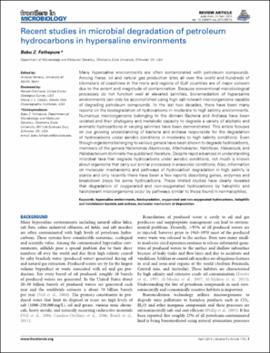| dc.contributor.author | Fathepure, Babu Z. | |
| dc.date.accessioned | 2019-08-28T16:00:43Z | |
| dc.date.available | 2019-08-28T16:00:43Z | |
| dc.date.issued | 2014-04-23 | |
| dc.identifier | oksd_fathepure_recentstudiesin_2014 | |
| dc.identifier.citation | Fathepure, B. Z. (2014). Recent studies in microbial degradation of petroleum hydrocarbons in hypersaline environments. Frontiers in Microbiology, 5. https://doi.org/10.3389/fmicb.2014.00173 | |
| dc.identifier.uri | https://hdl.handle.net/11244/321358 | |
| dc.description.abstract | Many hypersaline environments are often contaminated with petroleum compounds. Among these, oil and natural gas production sites all over the world and hundreds of kilometers of coastlines in the more arid regions of Gulf countries are of major concern due to the extent and magnitude of contamination. Because conventional microbiological processes do not function well at elevated salinities, bioremediation of hypersaline environments can only be accomplished using high salt-tolerant microorganisms capable of degrading petroleum compounds. In the last two decades, there have been many reports on the biodegradation of hydrocarbons in moderate to high salinity environments. Numerous microorganisms belonging to the domain Bacteria and Archaea have been isolated and their phylogeny and metabolic capacity to degrade a variety of aliphatic and aromatic hydrocarbons in varying salinities have been demonstrated. This article focuses on our growing understanding of bacteria and archaea responsible for the degradation of hydrocarbons under aerobic conditions in moderate to high salinity conditions. Even though organisms belonging to various genera have been shown to degrade hydrocarbons, members of the genera Halomonas Alcanivorax, Marinobacter, Haloferax, Haloarcula, and Halobacterium dominate the published literature. Despite rapid advances in understanding microbial taxa that degrade hydrocarbons under aerobic conditions, not much is known about organisms that carry out similar processes in anaerobic conditions. Also, information on molecular mechanisms and pathways of hydrocarbon degradation in high salinity is scarce and only recently there have been a few reports describing genes, enzymes and breakdown steps for some hydrocarbons. These limited studies have clearly revealed that degradation of oxygenated and non-oxygenated hydrocarbons by halophilic and halotolerant microorganisms occur by pathways similar to those found in non-halophiles. | |
| dc.format | application/pdf | |
| dc.language | en_US | |
| dc.publisher | Frontiers Media | |
| dc.rights | This material has been previously published. In the Oklahoma State University Library's institutional repository this version is made available through the open access principles and the terms of agreement/consent between the author(s) and the publisher. The permission policy on the use, reproduction or distribution of the material falls under fair use for educational, scholarship, and research purposes. Contact Digital Resources and Discovery Services at lib-dls@okstate.edu or 405-744-9161 for further information. | |
| dc.title | Recent studies in microbial degradation of petroleum hydrocarbons in hypersaline environments | |
| osu.filename | oksd_fathepure_recentstudiesin_2014.pdf | |
| dc.description.peerreview | Peer reviewed | |
| dc.identifier.doi | 10.3389/fmicb.2014.00173 | |
| dc.description.department | Microbiology and Molecular Genetics | |
| dc.type.genre | Article | |
| dc.type.material | Text | |
| dc.subject.keywords | hypersaline environments | |
| dc.subject.keywords | biodegradation | |
| dc.subject.keywords | oxygenated and non-oxygenated hydrocarbons | |
| dc.subject.keywords | halophilic and halotolerant bacteria and archaea | |
| dc.subject.keywords | molecular mechanism of degradation | |
